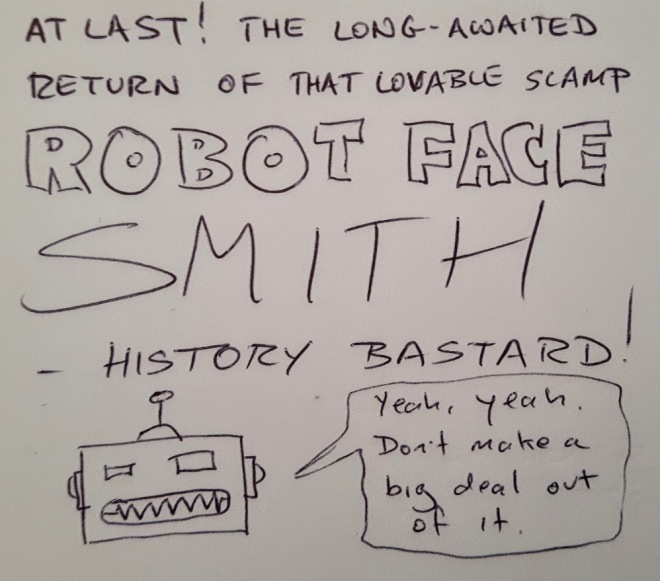
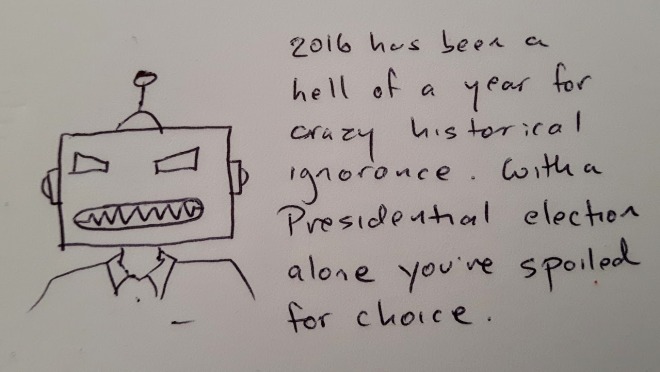
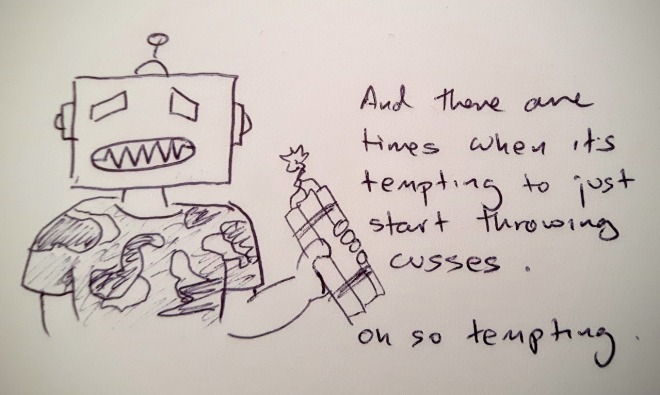
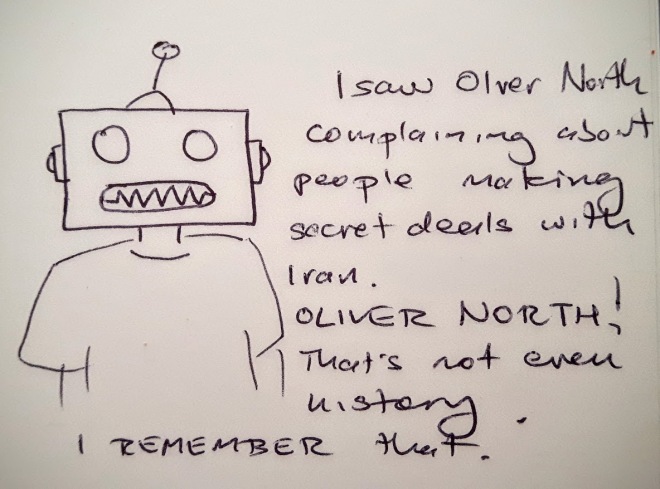
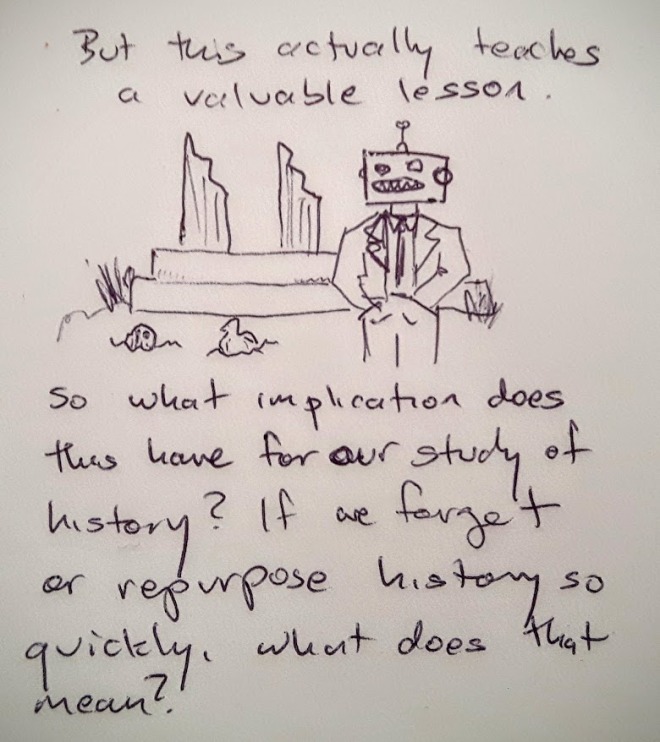







With this and last week’s TV Tuesday, it seems like I’m on a bit of a music-history kick at the moment. It’s just a coincidence, but it is an interesting one, since both The Get Down and Straight Outta Compton show some of the same traits — traits that are kind of universal in music movies.
Insofar as these traits are problems, they’re exaggerated because both Dr Dre and Ice Cube are credited as producers and other members of the group were involved in the production, as was Eazy-E’s widow, Tomica Woods-Wright. On the one hand, good for the musical side of things, but on the other hand, it’s a pretty rosy portrayal of the characters. My wife pointed out that some of the characters’ flaws sound like job interview answers — although everything I know suggests that Dr Dre is a workaholic perfectionist. Similarly, Ice Cube sometimes shouts and flies off the handle, which sounds like an older man acknowledging that he was a bit hot headed in his younger days.
And maybe that’s all it is, but the film did generate some controversy for its complete lack of anything related to Dre’s history of violence against women. In the movie, his girlfriend leaves him because he can’t support her and his child, which is the usual wife-doesn’t-believe-in-musician’s-artistic-dream plot. In reality, she alleges that he hit her. And of course Dee Barnes. Now, in real life Dre has apologised for all this, talked about his journey to maturity, and so on. But it’s just totally absent from the film. I guess there’s no good way they could have handled it, but still. And I gather Jerry Heller is not too pleased with how he was portrayed.
The other thing you always get in musical movies is compression and simplification. That’s got to suck if you’re left out of the story altogether (like the Arabian Prince) or forced into a villain/naysayer role (like Alonzo Williams). The compressed timeline also means that we see less of the members’ pre-NWA careers, although at least they’re discussed, something that really bugged me about Walk the Line. The musical story of it also highlights the police-brutality aspect: these are characters who live in a poor, violent neighbourhood where there is a lot of crime, but for the most part they themselves (except Eazy-E) aren’t criminals, except insofar as it’s unavoidable in that environment. In the film, Dre gets arrested for a brawl, but he was most often arrested for unpaid traffic tickets — i.e. for being broke. Suge Knight’s guys and Snoop nearly get into a fight over gang affiliations, which are just an unavoidable fact of life in that context. I wonder if that idea came home to people who are always complaining about thugs and criminals in hip-hop, but probably those guys aren’t watching an NWA biopic in the first place.
So the whole thing is enjoyable, but it’s more interesting than moving or exciting. Having been a teenager in the 90s, I got a lot of nostalgia moments and gained some context for some stuff I just casually learned about at that time. I was not a big gangster rap fan, but it was just so present in the culture at the time, and it was fascinating to see some reminders of another point of view. But it’s … y’know, it’s a music bio movie, and they are all more or less the same.
I said to Allison: “I was looking at the kid they have playing Ice Cube, and the resemblance was uncanny,” and she said, “his son?” And I said “yup.”
I made another reader questions video!
One thing that’s really missing from this video is discussion of how nations have historically responded to the fog of war. The most common way of dealing with poor communications between the central authority and armies out in the field has been to grant the commander a significant level of autonomy. This leaves a lot of the decision-making in the hands of the person with the most on-the-ground knowledge, but you will recall from the study of pretty much any period of history that highly autonomous commanders with armies loyal mainly to them have not always worked out great.
One way to get around that is, of course, to make sure the commander is someone who has a vested interest in seeing the ruling dynasty survive, such as the king’s nephew or son or some kind of gifted foreigner who could never rule, but obviously these methods have their own problems.
So, I have been watching The Get Down, Baz Luhrmann’s kinda-sorta music-history piece about the birth of hip-hop in the Bronx in the late 1970s. There’s been a lot of argument about historical inaccuracy in this show, and I’m not sufficiently knowledgeable to weigh in, except to say that I can definitely see a few places where things have been compressed, simplified, told out of sequence or reduced to a sort of cartoon of the reality.
Which … I said Baz Luhrmann, right? He’s not the only one involved, but he’s got previous for hearstring-tugging but not-exactly-coherent stories about the transformative power of music. Also for wild tonal inconsistency, which this also has. I enjoyed watching it, but it’s definitely kind of sloppy, less in a lot of ways than the sum of its parts.
But for me, I think the thing that really got me was that one of the storytelling choices was a real tough one for me to watch. So: two of the protagonists (well, at least two) are sort of torn between two worlds. Ezekiel (Justice Smith) is torn between a potentially bright future, going to college, pursuing a career in politics, his love interest Mylene (Herizen F. Guardiola), etc., and the music he loves so much, while Shaolin Fantastic (Shameik Moore) is torn between the same music and his commitment to the streets, the gang that raised him, etc.
The way in which this conflict is represented is … time-management anxiety. Lots and lots of anxious scenes about being in one place while you have to be in another, or fighting over competing demands on time. So … for me, that was not fun to watch. I get to see that stuff while I’m sleeping already.
It’s only a minor part, and it mainly illustrates what a weirdo I am, but there you go.

Things that are important in our everyday lives need patron saints, which is why in 1958 Pope Pius XII made 12th-13th century nun St Clare of Assisi the patron saint of TV. The idea, as I understand it, is that one time when she was sick she was miraculously able to see the Mass she couldn’t attend projected on the wall of her cell, which is a bit like television. Although I don’t believe the church considers watching Mass on TV to count.
Aaaaaanyway, my point is that sometimes historical examples get matched to modern concepts that they don’t quiiiite fit with because hey, historical examples are all you’ve got. You want to recognise the sacredness of something important in modern life, and you’re going to have to do that with a slightly off-model connection because that’s how drawing past-present analogies works.
All of which is to say that I was thinking about Saint Clare of Assisi when an editor asked me to write a piece on what the medieval equivalent of sexting was.
(It’s writing dirty letters, you guys. It’s always writing dirty letters.)
Anglesey Abbey, former country house of Lord Fairhaven, is one of those places near Cambridge that I’ve never been to because it’s not easy to get to on public transport. But with my wife’s family visiting, we thought it’d be nice to have a look at the house, take a stroll around the grounds, etc.
I don’t know why, but I have never been much of a stately-homes guy, despite the fact that places like Anglesey Abbey have lots of the stuff that I like about historic material culture.

Medieval things being reused as later things!

Desk envy!

Ephemera!

Library envy!

Henry IV!

And the ever-popular thief-proof door.
Well-informed staff were on hand to answer questions and the house wasn’t too skewed in favour of imagining the luxurious life of Lord Fairhaven. The recommended tour also takes you through the kitchens and so on (where people were making cake according to period recipes) and the little imagine yourself notes on the room guides exhort you to imagine yourself not only as the people who lived in the house but as their staff, although there wasn’t a note that said Imagine yourself as … the labouring poor, suffering through the bleak depths of the Great Depression while Lord Fairhaven and his idle brood lived in swinish luxury or anything.
I think my favourite thing was this:

Ah, the last days of prewar elegance, when Britain’s elite would gather in the library, chatting about the hunt, sippin’ on gin and juice, laid back, with their minds on their money and their money on their minds.
Anyway, there are also gardens, and I understand that people like them, but I have never yet been too excited about plants in a place. There is also a second-hand bookshop, which has always been more my thing, and where I got some, er, second-hand books.
I’ve done at least one previous Genghis Khan movie on this blog: the diabolical 1956 John Wayne vehicle The Conqueror. I haven’t done Sergei Bodrov’s 2007 Mongol, but I have seen it and it’s pretty entertaining, although it does kind of end just when things are getting good. Anyway, somehow I missed this one, directed by Henry Levin and starring Omar Sharif, but it’s on Netflix now, so let’s give it a look.

So, OK, it covers the sort of origin-story stuff you’d expect, beginning with young Temujin being enslaved following the death of his father and lots of horns going VWOOP VWOOP and whipping and stuff, and Michael Hordern being a wise old mentor to the lad. In fact, I wonder if this credits-sequence origin story wasn’t an inspiration for the relevant sections of Conan the Barbarian.
Anyway, Temujin catches the eye of Borte (Francoise Dorleac), who gazes beatifically at him while he gazes intently at her. I have to say that if you have a part that requires a lot of intent staring, Omar Sharif is probably your man. Borte looks about as white as she did when she was Susan Hayward, if not whiter. Jamuga (Stephen Boyd) is a sneering outright baddie and Borte is Temujin’s forbidden love; again, the historical Temujin and Borte were engaged from childhood.
Telly Savalas is the Telly Savalas character, Yvonne Mitchell is another sidekick, and there are lots of exciting adventures. Temujin makes a big speech about how women have to be respected and treated fairly, then kidnaps Borte from her tent and goes into the whole yer-beautiful-in-yer-wrath routine so familiar from many a previous Movie Monday. Fortunately it doesn’t last long, and soon Temujin and Borte are realising that niceness is better than meanness — although niceness expressed in lines like, er, “you talk too much, woman.” I guess he was kidding.
Meanwhile, Jamuga, to whom, if you recall, Borte was engaged, is all furious and, if possible, even greasier than he was before. And he was pretty goddamn greasy. Anyway, he goes and tries to recapture Borte, but danged if he doesn’t leave behind a clue that alerts Temujin’s faithful mute sidekick whatsisname. Yadda yadda, jilted lover, yadda yadda glare of defiance, yadda yadda daring rescue mission and I suddenly realised we’re only half an hour into this thing. Borte uglies him up pretty good with like a bear claw or maybe a marten or something, so that’s cool.

Anyway, Temujin and his boys attack in one of those highly implausible tactical uses of fire you get in movies. But Borte has probably been raped and is all torn up about the implied shame and what not. But Temujin is cool, because true love. The tribe goes on the run into the east to look for some kind of advantage that will help them get back at Jamuga and also, y’know, to get away from Jamuga because that dude doesn’t play.
So they go to China and they meet … well … it’s pretty rough. I’m not too happy with what I’m seeing here.

Yeah, it’s James Mason in yellowface. And he’s doing the voice, too. Anyway, by tactical niceness Omar Sharif befriends James Mason and together they go off. Also Borte is pregnant. Son is born and Temujin loves him as his own, etc. Anyway, they meet the emperor, who is another white dude (Robert Morley), and realise they have much to learn from Chinese culture, etc., etc. It turns out that the emperor has no intention of letting Temujin leave. But when disaster strikes, Temujin volunteers to help. There’s a bit of business with the emperor’s daughter (Susanne Hsiao, in wonder-of-wonders casting of an Asian actor to play an Asian role) and Borte’s brothers that is mainly distinguished for fantastic leaf placement.

Aaaanyway, the enemy leader turns out to be Jamuga himself, and Temujin fights him in a big set-piece battle with cavalry charges and bolt throwers and all sorts. Borte provides lessons in toughness and resolution, Temujin learns about gunpowder, Temujin, full of vengeance, refuses to kill Jamuga, blah blah blah. Seeing a threat from Temujin, the emperor conspires with Jamuga, and I swear there are still over 30 minutes left in this damn thing.
While Jamuga prowls the city lookin’ for vengeance, let’s go over the elements of the Genghis legend (they’re calling him Genghis by this point — with a soft G, no less!) they keep and the ones they discard. We have a rivalry between Temujin and Jamuga (or Jamukha or whatever), which is standard, and a love story with Borte, as well as the suspicion of Genghis’ son not being his. Some historical characters have script immunity — so for instance there’s a scene where Jamuga doesn’t kill Subutai because, you know, it’s Subutai and he has to live. Except the historical Subutai wasn’t Borte’s brother and this character has nothing in common with him. Perplexing.
So Genghis and the boys blow everybody up and ride off, apparently on special horses that don’t give a dang about just riding into a blazing inferno belching smoke and flame. The emperor is perturbed, but so what? It’s hey for the open steppe, but Jamuga is still at large. Regardless, Genghis plans world conquest in a scene that I assume never happened but is still pretty cool.

So while the whole thing plays out toward its inevitable final battle scene, let’s recap its strengths and weaknesses. First off, it is pretty racist. That’s hard to avoid. And the rape thing, which I have written about at length before. Just click on the movie Monday tag if you want an earful. Omar Sharif, of course, is a good actor, and even without a brilliant script he just turns up the charisma to 11 and glares intently at stuff. And of course, it’s full of 1965-vintage spectacle: sword fights, armies thundering past on horses, fireworks, people leaping off waterfalls, and lots of lovely landscapes (in Yugoslavia, I think?). It’s the kind of Hollywood big-budget spectacle that today would have a million identical CGI Mongols.
But overall, I mean … if it’s 1965 and you’re only gonna see one Omar Sharif movie this year, maybe Doctor Zhivago.
Eventually the preliminaries wrap up and Jamuga kills poor old James Mason, so it’s on. Clatter clatter hooves, boom boom cannons, kling clang swords. Wouldn’t you know it, Temujin and Jamuga end up facing off in single combat, in which, despite the fact that both of them have just been in a battle, only one of them is super greasy with sweat. Anyway, the final fight is good fun — and I take it back Omar Sharif is pretty greasy, must have been the lighting — but guess what? Our guy wins. But then he dies, which is a little premature, since in reality he lived over 20 years after uniting the Mongols and six or seven years after beating Khwarezm. Oh well.
I can’t believe I wrote 1200 words about this.
Today we headed over to the Fitzwilliam Musem for Colour, its exhibit of illuminated manuscripts with special reference to, er, colour. It was good!
Like other Fitz exhibits we’ve been to lately (especially Death on the Nile), it included a lot of focus on the technology and materiality of manuscript illuminations, rather than just considering them aesthetically. That’s always something I’m interested in, so good there, although I would have liked to have seen something on their social role. I mean, obviously they were high-status gifts, but how were they used, how displayed?
There were also some good mentions of the afterlives of these items, being passed around, cut up, copied, forged, sold to art collectors, vandalised to get the previous metals and so on. All very interesting.
I think my favourite piece was the alchemical scroll of George Ripley. I had seen images from it (or from others like it), but they don’t give you the impression of how huge it is. You really have to see it.

There was also a very cool image of the Battle of Clavijo on a Spanish patent of nobility that looked like something out of a Warhammer book (I know, I know, other way around), and a lovely image of a melancholic man. Anyway, if you’re in the area, you should go and see it; it’s informative, it’s not too large and it’s free.
Like many people in Britain, I pay attention to American politics, a hobby(?) helped by the fact that I lived for much of my life in the US. This year, what British and American politics have in common is that democratic processes have led to results that many people are unhappy with — Brexit here and the nomination of Donald Trump as the Republican presidential candidate back in America.
This is the kind of thing that predictably prompts some people to say “well, this is what democracy gets you in the olden days the told the mob what to think Plato was right all along grah grah grahr.”

This, I feel, is not a position supported by the historical evidence. It’s like that thing about dictatorships being more “efficient” than democracies. You could call Hitler’s Germany a lot of things, but “efficient” is not among them. It was a mess.
And the same goes for that other comparison so beloved of democracy’s critics, monarchy. Monarchies were a goddamn mess in pretty much any country that ever had one. An examination of the history of the British monarchy reveals a catalogue of bunglers, scoundrels, tomfools, irresponsible juveniles, would-be tyrants and just sonsabitches in general that makes the list of American presidents, Rutherford B. Hayes and Andrew Jackson included, look like a Sunday school picnic.
The critics have a point: people are (or at least can be) a bunch of damn fools. But where they err is in assuming that there is some subset of people who are not, and that they can be selected without reference to the aforementioned bunch of damn fools. Obviously, everyone thinks they’re special, but life is full of disappointments like that.
My keyboard has been acting up, and I’ve been getting ready for an event this weekend, so I’m afraid things are going to be a little quiet for the rest of the week. I do have a post queued up for the gaming blog, and I will try to catch up over the weekend, but we’ll see how it all goes. Normal service will be restored shortly, either way!